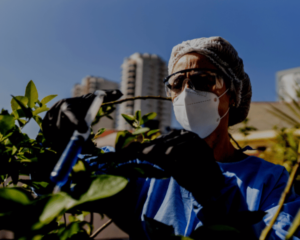Did you know that the best time to fertilize in spring depends on whether you’re growing cool or warm season grasses? This is real! Cool season grasses, those that thrive in cooler temperatures, are best fertilized in fall, when the growing season is at its peak. Of course, you can also add a small amount of slow-release fertilizer in the spring if you missed fertilizer last fall or your lawn isn’t looking great. For warm season grasses that love high temperatures, it is important to fertilize after vigorous growth begins in spring. So, when is the best time to fertilize your lawn in spring? Fertilizing in mid to late spring is ideal. This ensures healthy growth and suppresses weeds throughout the season.
Are you ready to start your spring landscaping? While spring is the best time to fertilize, here are some tips for handling fertilizer safely, as well as some other things you can do to promote a healthy lawn.
Handle fertilizer with care
 Read and follow package directions carefully before starting. It is also important to wear gloves and goggles when handling fertilizers, as most fertilizers contain chemicals that can irritate the skin and eyes. Keep pets and children away from the area during application and take other precautions as needed. Learn more about fertilizer and pet safety here. After fertilizing, be sure to sweep up any floating particles from walkways and wipe down garden equipment and shoe soles. This will prevent accidental contact with the fertilizer contents. Finally, store unused fertilizer in a safe, dry place out of the reach of pets and children. You can find more information on fertilizer safety and how often to fertilize your lawn find more here.
Read and follow package directions carefully before starting. It is also important to wear gloves and goggles when handling fertilizers, as most fertilizers contain chemicals that can irritate the skin and eyes. Keep pets and children away from the area during application and take other precautions as needed. Learn more about fertilizer and pet safety here. After fertilizing, be sure to sweep up any floating particles from walkways and wipe down garden equipment and shoe soles. This will prevent accidental contact with the fertilizer contents. Finally, store unused fertilizer in a safe, dry place out of the reach of pets and children. You can find more information on fertilizer safety and how often to fertilize your lawn find more here. Manicured lawn
Add compost to your lawn
Overseed
 To take care of your lawn, you need to start by clearing the ground. Mow your existing lawn to a very low height, then rake the area you want to seed to break up the soil. Then add compost or rich soil, grass seeds, and water, and watch the new grass grow over the next few days. Check out the information to learn more about how to properly care for your lawn find more here.
To take care of your lawn, you need to start by clearing the ground. Mow your existing lawn to a very low height, then rake the area you want to seed to break up the soil. Then add compost or rich soil, grass seeds, and water, and watch the new grass grow over the next few days. Check out the information to learn more about how to properly care for your lawn find more here. Receive professional lawn fertilization assistance
Our Services
Latest Posts
- Transform Your Outdoor Space: Top Landscape Design Trends for 2024
- How to Choose the Perfect Plants for Your Garden: Expert Tips
- Snow Relocation and Hauling: Strategies for Managing Excess Snow in Your Property
- DIY Snow Relocation and Hauling: Tips for Handling Excess Snow Efficiently
- Snow Salting and Sanding: Essential Techniques for Safe Winter Surfaces

